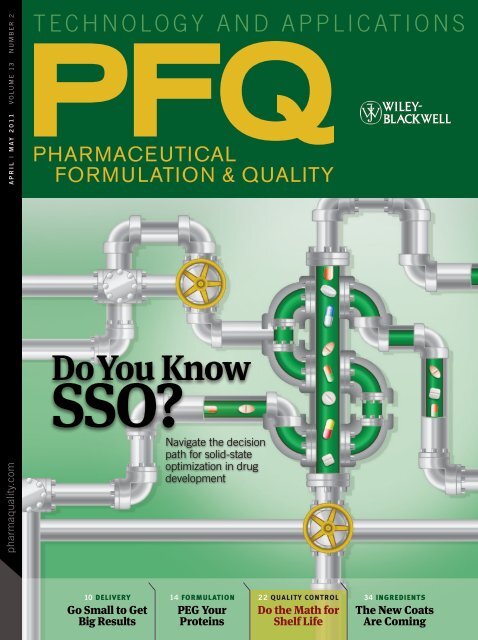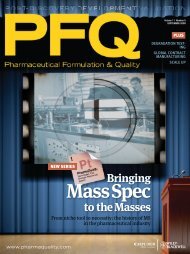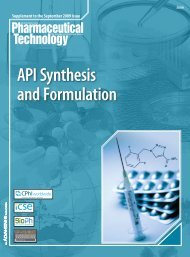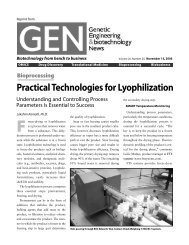High-Temperature Stability | Do the Math for Shelf Life - Sterile ...
High-Temperature Stability | Do the Math for Shelf Life - Sterile ...
High-Temperature Stability | Do the Math for Shelf Life - Sterile ...
- No tags were found...
You also want an ePaper? Increase the reach of your titles
YUMPU automatically turns print PDFs into web optimized ePapers that Google loves.
pharmaquality.com A P R I L I M A Y 2 0 1 1 V O L U M E 1 3 N U M B E R 2T E C H N O L O G Y A N D A P P L I C AT I O N S<strong>Do</strong>You KnowSSO?Navigate <strong>the</strong> decisionpath <strong>for</strong> solid-stateoptimization in drugdevelopment10 DELIVERYGo Small to GetBig Results14 FORMULATIONPEG YourProteins22 QUALITY CONTROL<strong>Do</strong> <strong>the</strong> <strong>Math</strong> <strong>for</strong><strong>Shelf</strong> <strong>Life</strong>34 INGREDIENTSThe New CoatsAre Coming
QUALITY CONTROLCAPSULESwedish scientist Svante Arrhenius provided <strong>the</strong> first kinetic model to interpret <strong>the</strong> effect of temperature on reaction rate. Since <strong>the</strong>n, pharmaceuticalscientists have often attempted to predict long-term chemical stability with insufficient understanding about <strong>the</strong> kinetic model, applying<strong>the</strong> practice in inappropriate situations. Understanding critical temperature relationships is <strong>the</strong> key to more accurately predicting long-term levels<strong>for</strong> a specific product.HIGH-TEMPERATURE STABILITY<strong>Do</strong> <strong>the</strong> <strong>Math</strong><strong>for</strong> <strong>Shelf</strong> <strong>Life</strong>Predict stability usingdata collected at highertemperatures> By Michelle Duncan, PhD,and Irene Zaretsky, MSPharmaceutical scientists routinelypredict long-term chemicalstability at a lowertemperature using data generatedat a higher temperature over a shortertime period. The use of 40 degrees C chemicaldata (e.g., assay and related substances)to predict levels over long-term 25degrees C storage has become such commonpractice that <strong>the</strong> underlying <strong>the</strong>ory isoverlooked or was never learned.There is disagreement about whe<strong>the</strong>rthree months at 40 degrees C indicates expected25 degrees C levels <strong>for</strong> 12 monthsor <strong>for</strong> 24 months because of insufficientunderstanding or in<strong>for</strong>mation about <strong>the</strong>kinetic model. More importantly, withoutsome <strong>the</strong>oretical understanding, <strong>the</strong>practice is inappropriately applied to situationsthat do not fit <strong>the</strong> kinetic modelupon which it is based, resulting in erroneouspredictions.In addition to providing <strong>the</strong> backgroundof how <strong>the</strong>se kinetic predictionswork, this paper will provide <strong>the</strong> key tounderstanding <strong>the</strong> temperature relationshipsand <strong>the</strong> ability to more accuratelypredict <strong>the</strong> expected long-term levels <strong>for</strong> aspecific product.Arrhenius Kinetics: WhereThis All BeganSwedish scientist Svante Arrhenius provided<strong>the</strong> first kinetic model to interpret <strong>the</strong>effect of temperature on reaction rate givenby Equation 1 (see info box). 1-3 The Arrheniusequation can be applied regardlessof <strong>the</strong> order (zero-order, first-order, etc.) of<strong>the</strong> reaction kinetics. 4 Equation 2 presents<strong>the</strong> linear <strong>for</strong>m of <strong>the</strong> Arrhenius equation<strong>for</strong> graphical presentation (y = mx + b).For many reactions, a linear relationshipcan be obtained between <strong>the</strong> inverse oftemperature (in degrees Kelvin) and <strong>the</strong>natural log (Ln) of <strong>the</strong> measured rate constant(k), as shown in Figure 1.Figure 1.THE ARRHENIUS EQUATIONK = A exp (-Ea/RT) (Equation 1)k = reaction rate constantA = Arrhenius factor (y-intercept constant)Ea = <strong>the</strong> energy of activation <strong>for</strong> <strong>the</strong> reaction, cal/mole(1000 cal = 1 kcal)R = <strong>the</strong> ideal gas constant, 1.987 calories/deg moleT = <strong>the</strong> absolute temperature (degrees Kelvin), <strong>for</strong> 25° CT= 298° K and <strong>for</strong> 40°C T= 313° K)THIS EQUATION CAN BE WRITTEN IN SEVERALEQUIVALENT FORMS AS FOLLOWS:Ln k = -Ea/RT + Ln A (Equation 2, y = mx + b)Ln k2/k1 = -Ea/R*(1/T2-1/T1) (Equation 3)k2 = k1 * exp[-Ea/R*(1/T2-1/T1)] (Equation 4)The constants k1 and k2 are <strong>the</strong> rate constants at temperatureT1 and T2 (<strong>for</strong> example 25 degrees C and 40degrees C), respectively.Equation 3 presents a simplified <strong>for</strong>m<strong>for</strong> use with two temperatures. Equation 4expresses <strong>the</strong> relationship between <strong>the</strong>reaction rates and <strong>the</strong> corresponding temperatureswhen <strong>the</strong> activation energy (Ea)of <strong>the</strong> reaction is known. Equation 4 allows<strong>for</strong> <strong>the</strong> calculation of a reaction rate constantat a lower temperature when <strong>the</strong> activationenergy and <strong>the</strong> reaction rate at <strong>the</strong>higher temperature are known.As shown by Figure 1, <strong>the</strong> Arrheniusmodel provides <strong>the</strong> ability to determine <strong>the</strong>reaction rate and, hence, predict stabilityat any temperature with knowledge of <strong>the</strong>activation energy (Ea) and <strong>the</strong> reaction rateat ano<strong>the</strong>r temperature.Limitations to Arrhenius’ ModelThe first requirement is a reaction (ongoing)where <strong>the</strong> reaction rate constant atArrhenius plot of Ln K against1/T. Slope = - Ea/R k = reactionrate constant, T = temperaturein degrees Kelvin Ea = activationenergy, R = ideal gas constant.© DREAMSTIME.COMPharmaceutical Formulation & Quality > April/May 2011
PHARMAQUALITY.COMa given temperature can be determined.When monitoring <strong>the</strong> generation of a primarydegradation product, <strong>the</strong> presenceof a secondary degradation reaction canintroduce error to <strong>the</strong> calculation of <strong>the</strong> primaryrate constant and any attempted Arrheniusmodel predicted rates. Likewise,if a component is consumed to <strong>the</strong> extentthat <strong>the</strong> reaction equilibrium changes, <strong>the</strong>reaction rate will not remain constant. TheArrhenius kinetic model requires a reactionrate constant (k).Figure 2.The zero-order kinetic model <strong>for</strong> 10% drug lossover 24 months at 25 degrees C shown as <strong>the</strong>percent of drug remaining as a function of timeat 25 degrees C.The Arrhenius kinetic model can be utilizedacross <strong>the</strong> temperature range where aconstant relationship between <strong>the</strong> effect oftemperature on <strong>the</strong> reaction rate is maintained,where <strong>the</strong> graph is linear. The reactionmechanism should not change over <strong>the</strong>temperature range studied. Con<strong>for</strong>manceto <strong>the</strong> model (linearity) is often lost whencrossing a phase change, such as freezingand <strong>the</strong> glass-phase transition of proteinsand peptides. Reactions where <strong>the</strong> rate isdependent upon oxygen, light (photochemical),diffusion, or microorganism-baseddecomposition may not demonstrate Arrheniuskinetics over any temperature range.Figure 3.Table 1.Months at 40degrees C to reach10% drug loss63Relationship of reaction rates at 40 degrees C and activationenergy (Ea) <strong>for</strong> drug lossk40 (drug %labelclaim per month)-1.6667-3.3333Finding Ea <strong>for</strong> <strong>the</strong> ReactionThe activation energy (Ea) <strong>for</strong> a reactioncan be determined by conducting stabilitystudies at several different temperaturesand applying <strong>the</strong> Arrhenius kinetic model.The slope of <strong>the</strong> line <strong>for</strong>med with Equation2 contains Ea, as demonstrated in Figure 1.<strong>High</strong>er temperatures (e.g., 55 degrees C,70 degrees C) and corresponding shortertimes (e.g., weeks, days) can be employed<strong>for</strong> this determination provided <strong>the</strong> Arrheniuskinetic model remains valid (see Limitationsto Using Arrhenius Kinetic Model).The Ea <strong>for</strong> drug decomposition will usuallyfall in <strong>the</strong> range of 12 to 24 kcal/mole, witha typical value of 19 to 20 kcal/mole. 5 Theactivation energy can be approximatedbased upon prior knowledge of <strong>the</strong> drugdecomposition kinetics. Once <strong>the</strong> Ea isknown, it usually remains valid <strong>for</strong> usethrough small concentration changes orslight <strong>for</strong>mulation changes.Importance of Ea: TheoreticalModel <strong>for</strong> Drug LossThe following discussion demonstrates <strong>the</strong> relationshipof drug degradation kinetics at 40degrees C and 25 degrees C, where drug lossis <strong>the</strong> shelf life-determining parameter. Forthis illustration, acceptable product stabilityis based upon a lower limit of 90% label claimk25 (drug %labelclaim per month)-0.4167-0.4167Ea (kcal/mole)activation energy1726and <strong>the</strong> expiration date set at exactly 90% labelclaim. For this exercise, a zero-orderdegradation kinetics model (Δdrug/Δtime =—k) is applied to determine <strong>the</strong> rate <strong>for</strong> 10%of drug loss occurrence over 24 months at 25degrees C (Figure 2). The slope was calculatedand is equal to —0.4167 drug %labelclaim/ month, which is <strong>the</strong> reaction rate constantat 25 degrees C (k25). Hence, <strong>for</strong> <strong>the</strong> drugto remain within acceptance criteria <strong>for</strong> 24months at 25 degrees C, <strong>the</strong> rate of degradationat 25 degrees C must be less than 0.4167drug %label claim/month.In a similar manner, drug loss can bemodeled at 40 degrees C accelerated temperature<strong>for</strong> <strong>the</strong> two scenarios of 10% drug lossoccurring at three months and at six months(Figure 3). The slopes, which represent <strong>the</strong>reaction rate constant at 40 degrees C (k40),were calculated to be —1.6667 drug %labelclaim/month <strong>for</strong> <strong>the</strong> six months limit scenarioand —3.3333 drug %label claim/month <strong>for</strong> <strong>the</strong>three months limit scenario.Using <strong>the</strong> Arrhenius equation (Equation3) and <strong>the</strong> reaction rates at 25 degrees C and40 degrees C, <strong>the</strong> Ea can be calculated asshown in Table 1. The Arrhenius equationcan be applied regardless of <strong>the</strong> order of <strong>the</strong>reaction kinetics. For <strong>the</strong> kinetic model thatassumes 10% drug loss at 24 months at 25degrees C (k25 = —0.4167 drug %labelTable 2.Relationship of reaction rates at 40 degrees C and activationenergy (Ea) <strong>for</strong> impurity generationMonths at 40degrees C <strong>for</strong> impurityto reach 1%k40 (%w/wimpurity per month)k25 (%w/wimpurity per month)Ea (kcal/mole)activation energy60.16670.041717Zero-order kinetic models <strong>for</strong> 10% drug lossover three months and over six months at 40degrees C.30.33330.041726April/May > Pharmaceutical Formulation & Quality
QUALITY CONTROL | HIGH-TEMPERATURE STABILITYTable 3.Months at 25degrees C toreach 1.0% w/wdegradant limit(kinetic shelf life)241812claim/month) and 10% drug loss at threemonths at 40 degrees C (k40 = —3.3333 drug%label claim/month), <strong>the</strong> calculated Ea is 26kcal/mole. For <strong>the</strong> model that assumes 10%drug loss at 24 months at 25 degrees C (k25 =—0.4167 drug %label claim/month) and 10%drug loss at six months at 40 degrees C (k40= —1.6667 drug %label claim/month), <strong>the</strong>calculated Ea is 17 kcal/mole.Knowledge of <strong>the</strong> Ea is key to <strong>the</strong> interpretationof accelerated data <strong>for</strong> predictionsat lower temperatures. If <strong>the</strong> Ea islow (less than or equal to 17 kcal/mole), <strong>the</strong>accelerated 40 degrees C drug concentrationmust remain greater than 90% labelclaim <strong>for</strong> six months to achieve at least90% label claim <strong>for</strong> a shelf life of 24Table 4.Months at 25degrees C toreach 1.0% w/wdegradant limit(kinetic shelf life)2418129Relationship of rates and activation energy (Ea) <strong>for</strong> shelf-lifestability when limit is reached after six months at 40 degrees C.k25 (%w/w permonth) Rate ofdegradant growth at25 degrees Cthrough shelf life0.04170.05560.0834k40 (%w/w permonth) Rate ofdegradant growth at40 degrees C when1.0% w/w limit isreached at sixmonths0.16670.16670.1667Ea (kcal/mole)activation energy1714month at 25 degrees C. If <strong>the</strong> Ea is high(more than or equal to 26 kcal/mole), <strong>the</strong>accelerated 40 degrees C drug concentrationmust remain greater than 90% labelclaim <strong>for</strong> only three months (and be 80%label claim at six months), and yet <strong>the</strong>product will remain at or above 90% labelclaim <strong>for</strong> a shelf life of 24 month at 25 degreesC. This application of Ea and Arrheniuskinetics to predict shelf life can beapplied to any drug level (limit) specified.Theoretical Model <strong>for</strong>Impurity/Degradant GenerationThe same approach can be used to understandand predict <strong>the</strong> generation of impurities/degradants.For this exercise, aRelationship of rates and activation energy (Ea) <strong>for</strong> shelf-lifestability when limit is reached after three months at 40 degrees C.k25 (%w/w permonth) Rate ofdegradant growth at25 degrees Cthrough shelf life0.04170.05560.08340.1111k40 (%w/w permonth) Rate ofdegradant growth at40 degrees C when1.0% w/w limit isreached at threemonths0.33330.33330.33330.33339Ea (kcal/mole)activation energy26221714zero-order degradation kinetics model(ΔImpurity/Δtime = —k) is applied to determine<strong>the</strong> rates <strong>for</strong> an arbitrary 1% impuritygrowth at 25 degrees C and at 40degrees C. The calculated slope <strong>for</strong> growthfrom 0 to 1.0% w/w over 24 months at 25degrees C is equal to 0.0417% w/w permonth, which is <strong>the</strong> impurity generationrate constant at 25 degrees C (k25). In <strong>the</strong>same manner, <strong>the</strong> impurity generationrate at 40 degrees C can be calculated <strong>for</strong>reaching 1.0% w/w after three months(0.3333% w/w per month) and <strong>for</strong> reaching1.0% w/w after six months storage (0.1667%w/w per month). Table 2 summarizes <strong>the</strong>corresponding rates and Eas:Example calculationWhere:Ln k 2 /k 1 = -Ea/R*(1/T 2 -1/T 1 ) (Equation 3)Ln (k40/k25) = - [Ea/1.987*(1/313-1/298)]/1000cal/kcalk40 = 0.1667%w/w degradant/monthk25 = 0.0417%w/w degradant/monthSolving <strong>for</strong> Ea:Ea = - [Ln (0.1667/0.0417)*1.987]/[(1/313-1/298)*1000]Ea = 17 kcal/moleAs <strong>the</strong> Ea increases, <strong>the</strong> reaction rateat 40 degrees C increases. The degradantlevel at six months at 40 degrees C is predictiveof <strong>the</strong> degradant level to be reachedafter 24 months at 25 degrees C when <strong>the</strong> Eais 17 kcal/mole. Degradants with reactionmechanisms with high activation energies(greater than 17 kcal/mole) can exhibitlevels exceeding 1.0% w/w by six monthsat 40 degrees C, yet have 25 degrees C valuesbelow <strong>the</strong> 1.0% w/w limit.<strong>Shelf</strong> <strong>Life</strong>, Rates, andActivation EnergyTo demonstrate <strong>the</strong> importance of Ea inpredicting long-term shelf life at 25 degreesC from 40 degrees C rates, <strong>the</strong> Arrheniuskinetic equation was used to demonstrate<strong>the</strong> relationship of reaction rates and Ea. Therelationships are demonstrated in Table 3<strong>for</strong> <strong>the</strong> scenario where <strong>the</strong> degradantreaches <strong>the</strong> 1.0% w/w limit at six monthsat 40 degrees C and <strong>the</strong> zero-order rateconstant (k40) is equal to 0.1667% w/wdegradant/month.Table 4 demonstrates <strong>the</strong>se relationships<strong>for</strong> <strong>the</strong> scenario where <strong>the</strong> degradantreaches <strong>the</strong> 1.0% w/w limit at three monthsat 40 degrees C and <strong>the</strong> zero-order rateconstant (k40) is equal to 0.3333% w/wPharmaceutical Formulation & Quality > April/May 2011
PHARMAQUALITY.COMCASE STUDYPredict Dextrose DegradationIt is widely reported that dextrose in solution degrades to <strong>for</strong>m 5-hydroxymethylfurfural(5-HMF) during heating (terminal sterilization) and overtime. 6-8 According to <strong>the</strong> dextrose injection monograph in <strong>the</strong> USP, <strong>the</strong>limit <strong>for</strong> 5-HMF and related substances is not more than 0.25 absorbanceunits at 284 nm wavelength. 9The multiple pathway <strong>for</strong>mation of 5-HMF by dehydration of dextrose isdepicted in Figure A. 10 The overall kinetic scheme, involving an intermediate,Figure A.Possible mechanism of 5-HMF <strong>for</strong>mation in dextrose solutions(reference 10).Figure B.Simplified reaction scheme <strong>for</strong> 5-HMF <strong>for</strong>mation.Substances and Products, requires long-term testing over 12 months atroom temperature (25 degrees C or 30 degrees C) and over six months ataccelerated conditions of 40 degrees C at <strong>the</strong> time of submission. The document’sObjections of <strong>the</strong> Guidance section states: “The guidance exemplifies<strong>the</strong> core stability data package <strong>for</strong> new drug substances and products,but leaves sufficient flexibility to encompass <strong>the</strong> variety of different practicalsituations that may be encountered due to specific scientific considerationsand characteristics of <strong>the</strong> materials being evaluated. Alternative approachescan be used when <strong>the</strong>re are scientifically justifiable reasons.” 12The known chemistry of dextrose degradation to 5-HMF as presentedhere represents a justifiable reason <strong>for</strong> submitting a shorter time period ofaccelerated data. The kinetic model with known activation energy indicatesthat submission of two months at 40 degrees C data is sufficient and moreappropriate than six months at 40 degrees C data to estimate <strong>the</strong> level of5-HMF at 25 degrees C and to support a requested 24 months at 25 degreesC expiration dating period. nwith definable rate constants <strong>for</strong> <strong>for</strong>mation andreaction, has been published by at least threegroups. 11 The Eas <strong>for</strong> k 1 and k 2 of <strong>the</strong> reactionscheme shown in Figure B, as determined bySturgeon and colleagues, are 32.6 kcal/mole and12.3 kcal/mole, respectively. Previously, Heimlichand Martin determined <strong>the</strong> Ea <strong>for</strong> 5-HMF <strong>for</strong>mationfrom dextrose to be 31.2 kcal/mole and 31.8kcal/mole, dependent upon <strong>the</strong> method used todetermine <strong>the</strong> first-order rate constant. 11Be<strong>for</strong>e appreciable <strong>for</strong>mation of 5-HMF canoccur, a reasonably high steady state level of <strong>the</strong>intermediate must first be established. Thus, <strong>the</strong>overall generation of 5-HMF will be dependent upon<strong>the</strong> k 1 with an activation energy of 32.6 kcal/mole.Using Table 5 and <strong>the</strong> Ea of 31 kcal/mole listing, <strong>the</strong>last column indicates that 5-HMF levels measuredafter two months at 40 degrees C will be predictiveof 24 months at 25 degrees C. The production of5-HMF is proceeding at least 12 times faster at 40degrees C than at 25 degrees C. The level of 5-HMFafter six months at 40 degrees C will be three timeshigher than <strong>the</strong> level reached at 24 months at25 degrees C.The U.S. Food and Drug Administration/InternationalConference on Harmonisation Guidance <strong>for</strong>Industry, Q1A(R2), <strong>Stability</strong> Testing of New DrugTable 5.Ea(kcal/mole)activationenergy9141720222631<strong>Stability</strong> predictions based upon <strong>the</strong> ratio of rates (Ea) at 40degrees C and 25 degrees C.Ratio (R)k40 to k25(k40 =R*k25)23456812Requiredmonths at 40degrees Cto reach levelequivalent to12 months at25 degrees C6432.521.51Requiredmonths at 40degrees Cto reach levelequivalent to18 months at25 degrees C964.53.632.251.5Requiredmonths at 40degrees Cto reach levelequivalent to24 months at25 degrees C12865432April/May > Pharmaceutical Formulation & Quality
QUALITY CONTROL | HIGH-TEMPERATURE STABILITYFigure 4.Predicteddegradant <strong>for</strong>mationat 25 degreesC when 1% w/wdegradation isreached afterthree months at40 degrees C <strong>for</strong>different activationenergies (Ea).Figure 5.Kinetic model <strong>for</strong>1% w/w degradant<strong>for</strong>mation afterthree months at40 degrees C.degradant/month. The zero-orderdegradant generation rates at 25 degreesC (k25) are calculated <strong>for</strong> reaching 1.0%w/w at different expiry time intervals: 12,18, and 24 months (Tables 3 and 4). For<strong>the</strong>se examples, <strong>the</strong> initial time zero startinglevel is set to 0% w/w. As shown in Tables3 and 4, each of <strong>the</strong>se differentshelf-life scenarios has a reaction mechanismwith a different Ea.As <strong>the</strong> Ea decreases, <strong>the</strong> reaction rateat 25 degrees C increases relative to <strong>the</strong>rate at 40 degrees C. The temperature sensitivityof <strong>the</strong> reaction decreases with decreasedactivation energy, as indicated by<strong>the</strong> decreased proportionality between<strong>the</strong> rates (k40 α k25). When <strong>the</strong> activationenergy is 9 kcal/mole (very low), evenwhen remaining within <strong>the</strong> limit of 1.0%w/w degradation through six months at40 degrees C, a maximum of 12 months at25 degrees C shelf life can be projected.In comparison, when activation energyis 17 kcal/mole with 1.0% w/w degradationthrough six months at 40 degreesC, 24 months elapses be<strong>for</strong>e <strong>the</strong> same1.0% w/w degradant level is reached at25 degrees C. If <strong>the</strong> Ea is known to be 17kcal/mole or greater, <strong>the</strong>n 40 degrees Cvalues at six months of 1.0% w/w (or less)can kinetically support a shelf life, <strong>for</strong> thisdegradant limit, of 24 months at 25 degreesC. (This article does not address dataaccuracy—variability of <strong>the</strong> analyticalmethodology and/or <strong>the</strong> product samples—or<strong>the</strong> use of confidence intervals,Editor’s Choice1. Weiss WF IV, Young TM, Roberts CJ. Principles, approaches, and challenges <strong>for</strong> predicting protein aggregation rates and shelf life.J Pharm Sci. 2009;98(4):1246-1277.2. Zahn M, Kållberg PW, Slappendel GM, et al. A risk-based approach to establish stability testing conditions <strong>for</strong> tropical countries.J Pharm Sci. 2006;95(5):946-965.3. Waterman KC, Adami RC. Accelerated aging: Prediction of chemical stability of pharmaceuticals. Inter J Pharm. 2005;293:101-125.4. Beaman J, Whitlock M, Wallace R, et al. The scientific basis <strong>for</strong> <strong>the</strong> duration of stability data required at <strong>the</strong> time of submission.J Pharm Sci. 2010;99(6):2538-2543.5. Bauer M. <strong>Stability</strong> of drug substances and drug products: Considerations on <strong>the</strong> stability of drug substances and <strong>for</strong>mulation in<strong>the</strong> pharmaceutical industry domain. STP Pharma Pratiques 2005;15(3):232-246.Pharmaceutical Formulation & Quality > April/May 2011
PHARMAQUALITY.COMFigure 6.Figure 7.Degradant reached 1%w/w at 40 degrees C; each model predicts <strong>the</strong>same level at 25 degrees C.Degradant level at 25 degrees C <strong>for</strong> <strong>the</strong> three activation energymodels in Figure 6.which should also be incorporated whenestablishing product shelf life.)Because many drugs demonstrate Easof 19-20 kcal/mole, this is <strong>the</strong> basis <strong>for</strong> <strong>the</strong>practice of comparing six month 40 degreesC values against <strong>the</strong> specification limit as apredictor of meeting that specificationthrough a shelf life of 24 months at 25 degreesC. The proportionality of six monthsstorage at 40 degrees C as predictive of 24months at 25 degrees C is predicated uponan activation energy of at least 17 kcal/mole.Some reactions proceed relatively fastat higher temperatures, as demonstrated inTable 4 and Figure 4. In this example, <strong>the</strong>degradant growth at 40 degrees C reaches<strong>the</strong> product limit (assigned here as 1.0%w/w) after three months storage (k40 =0.3333%w/w degradant per month). Theusual response is to assume that only a 12-month shelf life at 25 degrees C can beachieved. In reality, <strong>the</strong> levels of degradantreached at 25 degrees C are dependent upon<strong>the</strong> Ea of <strong>the</strong> reaction as shown in Figure 5.The proportionality of <strong>the</strong> level measuredafter three months at 40 degrees C aspredictive of <strong>the</strong> level <strong>for</strong> 12 months at 25degrees C is valid only <strong>for</strong> an Ea of 17kcal/mole. If <strong>the</strong> activation energy is knownto be 22 kcal/mole or greater, <strong>the</strong>n 40 degreesC values at three months up to 1.0%w/w can kinetically support a shelf life,<strong>for</strong> this degradant limit, of 18 months at25 degrees C. This application of Ea andArrhenius kinetics to <strong>the</strong> prediction ofshelf life can be applied to any degradantlevel specified.<strong>Stability</strong> Prediction Made EasyNow that <strong>the</strong> relationship of reaction ratesto Ea is understood, it becomes easier topredict values over longer time periods atlower storage temperatures, like 25 degreesC, from values obtained at higher(accelerated degradation) temperatures,such as 40 degrees C.The Ea is <strong>the</strong> proportionality factor betweenreaction rates at different temperatures(k40 α k25). The Arrhenius equation(Equation 4) can be solved <strong>for</strong> <strong>the</strong> exactrelationship between reaction rates at 40degrees C and 25 degrees C <strong>for</strong> any activationenergy Ea. This proportionality canbe used to predict levels and shelf life, aspresented in Table 5. When <strong>the</strong> activationenergy is 17 kcal/mole, <strong>the</strong> same degradantlimit is reached at six months at 40 degreesC and at 24 months at 25 degrees C.Table 5 can be used as a guide to interpret40 degrees C kinetic prediction of 25degrees C shelf life. As data is collectedover time at 40 degrees C, <strong>the</strong> results ateach test interval can be used to predict <strong>the</strong>level and, hence, <strong>the</strong> shelf life at 25 degreesC. When <strong>the</strong> activation energy is greaterthan 17 kcal/mole, samples stored at 40 degreesC and tested at six months will exhibitlevels greater than what will be actuallyreached over 24 months at 25 degrees C. If<strong>the</strong> activation energy is 26 kcal/mole, <strong>the</strong>level measured at three months at 40 degreesC represents <strong>the</strong> expected level <strong>for</strong>24 months at 25 degrees C, and <strong>the</strong> levelmeasured at six months at 40 degrees Cwill actually represent twice <strong>the</strong> expectedlevel <strong>for</strong> 24 months at 25 degrees C.The concept presented in Table 5 isshown in Figures 6 and 7. Figure 6 showsthree different rate scenarios <strong>for</strong> <strong>the</strong> monthsat 40 degrees C to reach 1% w/w degradant.When <strong>the</strong> Ea <strong>for</strong> <strong>the</strong> reaction is 26 kcal/moleor greater, although <strong>the</strong> 1% w/w level isreached by three months at 40 degrees C(k40 = 0.3333% w/w degradant/month), <strong>the</strong>degradant growth at 25 degrees C will notreach 1%w/w until 24 months or beyond,as represented in Figure 7.When <strong>the</strong> Ea <strong>for</strong> <strong>the</strong> reaction is 22 kcal/mole and at four months at 40 degrees C<strong>the</strong> 1% w/w level is reached (k40 = 0.2500%w/w degradant/month), <strong>the</strong> degradantgrowth at 25 degrees C will again not reach1%w/w until 24 months, as represented inFigure 7. An Ea of 17 kcal/mole and a sixmonths 40 degrees C degradant level of1% w/w (k40 = 0.1667% w/w degradant/month) likewise corresponds to a projectionof 24 months at 25 degrees C to reach1% w/w. Thus, as demonstrated, differentrates at 40 degrees C can project to <strong>the</strong>same or similar stability at 25 degrees C.Additionally, as indicated in Table 5, <strong>for</strong><strong>the</strong> same activation energy of 17 kcal/mole,when <strong>the</strong> degradation rate at 40 degrees Cis faster, reaching 1% w/w by three months(k40 = 0.3333% w/w degradant/month),<strong>the</strong> 1%w/w level is projected to be reachedby 12 months at 25 degrees C (Figures 4and 5). A shelf life of 12 months is kineticallysupported. Consequently, if <strong>the</strong> activationenergy is lower than 17 kcal/mole<strong>for</strong> this same k40 rate of reaching 1% w/wApril/May > Pharmaceutical Formulation & Quality
QUALITY CONTROL | HIGH-TEMPERATURE STABILITYby three months (k40 = 0.3333% w/wdegradant/ month), levels at 25 degrees Cwill reach 1% w/w be<strong>for</strong>e 12 months, and ashelf life of 12 months is not kineticallysupported. The in<strong>for</strong>mation in Table 5 canbe used to estimate shelf life based upon<strong>the</strong> Ea and stability at 40 degrees C.The practice of predicting long-termchemical stability at a lower temperatureusing data generated at a higher temperatureover a shorter time period is basedupon application of <strong>the</strong> Arrhenius kineticmodel. The Arrhenius equation can beapplied regardless of <strong>the</strong> order of <strong>the</strong> reactionkinetics. By using <strong>the</strong> Ea with <strong>the</strong>experimental level of drug or degradantobtained at a higher temperature (40degrees C), <strong>the</strong> expected level of drug ordegradant over long-term storage at alower temperature (25 degrees C) can bemore accurately predicted and <strong>the</strong> kineticshelf life estimated. The proportionalityof six months storage at 40degrees C as predictive of 12 months at25 degrees C is predicated upon an activationenergy of 9 kcal/mole. The proportionalityof six months storage at 40degrees C as predictive of 24 months at25 degrees C is predicated upon an activationenergy of 17 kcal/mole. As <strong>the</strong>activation energy increases, <strong>the</strong> temperaturesensitivity of <strong>the</strong> reaction increases,resulting in a greaterdifference in <strong>the</strong> rates at different temperatures.The in<strong>for</strong>mation in Table 5can also be used to estimate shelf life at25 degrees C based upon <strong>the</strong> activationenergy and <strong>the</strong> stability at 40 degreesC. As presented, <strong>the</strong> Arrhenius kineticmodel can be applied to specific drugchemistry to scientifically justify appropriatemonths at accelerated 40 degreesC condition <strong>for</strong> submission. nREFERENCES1. Martin A. Physical Pharmacy: PhysicalChemical Principles in <strong>the</strong> PharmaceuticalSciences. 4 th ed. Philadelphia: Lea &Febiger; 1993: Chapter 12, Kinetics, pages284-323.2. Lachman L, Lieberman HA, Kanig JL. TheTheory and Practice of Industrial Pharmacy.3 rd ed. Philadelphia: Lea & Febiger;1986:765-767.3. Wigent RJ. Chemical kinetics. In: GennaroAR, ed. Remington: The Science and Practiceof Pharmacy. 20 th ed. Philadelphia:Lippincott Williams & Wilkins; 2000.4. Carstensen JT. Drug <strong>Stability</strong>: Principles andPractices. New York: Marcel Dekker;1990:29-34.5. Conners KA, Amidon GL, Stella VJ. Chemical<strong>Stability</strong> of Pharmaceuticals: A Handbook <strong>for</strong>Pharmacists. 2 nd ed. New York: John Wiley &Sons; 1986:24.6. Brönsted JN, Guggenheim EA. Contributionto <strong>the</strong> <strong>the</strong>ory of acid and base catalysis: <strong>the</strong>mutarotation of glucose. J Am Chem Soc.1927;49(10):2554-2584.7. Taylor RB, Jappy BM, Neil JM. Kinetics ofdextrose degradation under autoclaving conditions.J Pharm Pharmacol. 1972;24(2):121-129.8. Sturgeon RJ, Athanikar NK, Hartison HA, etal. Degradation of dextrose during heatingunder simulated sterilization. J Parenter DrugAssoc. 1980;34(3):175-182.9. U.S. Pharmacopeia–National Formulary. Dextroseinjection monograph. Available at:www.uspnf.com.10. Hryncewicz CL, Koberda M, Konkowski MS.Quantitation of 5-hydroxymethylfurfural (5-HMF) and related substances in dextroseinjections containing drugs and bisulfite. JPharm Biomed Anal. 1996;14(4):429-434.11. Heimlich KR, Martin AN. A kinetic study ofglucose degradation in acid solution. J AmPharm Assoc. 1960;49(9):592-597.12. U.S. Food and Drug Administration. Center<strong>for</strong> Drug Evaluation and Research. Center <strong>for</strong>Biologics Evaluation and Research. Guidance<strong>for</strong> Industry: Q1A(R2) <strong>Stability</strong> Testing of NewDrug Substances and Products. Washington,D.C.: U.S. Food and Drug Administration;2003.Michelle Duncan is an associate director in global research and development withBaxter Healthcare. She holds a bachelor’s in biochemistry and molecular biology fromNorthwestern University and earned her PhD in pharmaceutics from <strong>the</strong> University ofTexas at Austin. She specializes in <strong>the</strong> <strong>for</strong>mulation development of parenteral products and hasled numerous injectables through FDA approval (NDA and ANDA routes) and to successful commercialization.Irene Zaretsky is a research associate with Baxter, supporting analytical and<strong>for</strong>mulation development. She earned her master’s in chemistry from <strong>the</strong> Institute of Technologyin Minsk, Belarus, and has worked more than 13 years in <strong>the</strong> U.S. pharmaceutical industry.BaxterBioPharmaSolutions.comContact us at biopharmasolutions@baxter.comReprinted with permission from PFQ Magazine April/May 2011.






